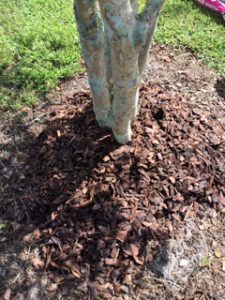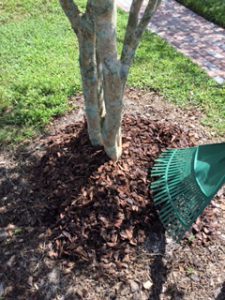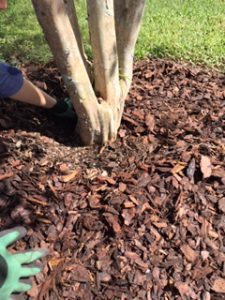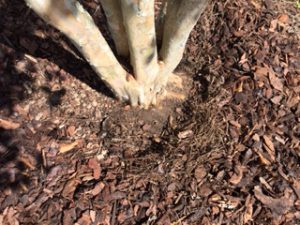Protecting tree roots with organic mulch has many benefits. Mulch creates a safe zone around the tree area, eliminating potential injuries from mowers and string-trimmers. Mulch can separate major root zone areas from nearby sod areas, and breaks down, enriching the soil and providing nutrients to tree roots. Finally, mulch moderates soil temperatures, decreases erosion and aids in drainage. Indeed, the proper use of mulch in a landscape is such an important benefit, it’s one of the nine principles of Florida-Friendly Landscaping™!

Yet, sometimes good practices can be misunderstood, and incorrect mulching around trees is an example of a misunderstood practice that can lead to increased pests, diseases and ultimately can cause the death of trees. What is “volcano mulching”, and why is it harmful? How has volcano mulching become widespread? What is the correct and healthy way to mulch around trees?
Volcano mulching is the incorrect placement of mulch against the trunk of a tree. As mulch is layered higher and higher against the tree trunk, the trunk appears to be “erupting” from a volcano-shaped pile of mulch. The trunk appears as a telephone-pole shape; the natural flare of the tree trunk is covered. Unfortunately, this is a practice that is so prevalent, and seen so often in our urban landscapes that it appears to be an accepted way to apply mulch. Research from UF/IFAS, as well as the ISA (International Society of Arboriculture) consistently recommends against the practice of volcano mulching.
WHY IS VOLCANO MULCHING HARMFUL?
Piling mulch against a tree trunk harms the tree in the following ways:
1) It holds moisture against the trunk and roots of the tree, leading to fungal diseases and rot.
2) It harbors insects, increasing pest disease; and can also harbor small rodents who chew on tree bark.
3) It encourages roots to grow laterally into the mulch, causing roots to encircle or girdle the trunk, rather than to spread out into the soil. This weakens the tree’s support system.

Eventually the combination of the above stresses can lead to the decline and death of a tree.
HOW HAS THIS PRACTICE BECOME WIDESPREAD?
Likely causes of the increased practice of volcano mulching include:
1) The belief that if some mulch is good, “more” must be better.
2) Seasonal contracts with landscape maintenance companies (both residential and commercial) that call for a refreshing of mulch in tree beds. Rather than assessing the recommended depth of existing mulch (2-3 inches deep); and rather than raking away existing mulch from the center of the tree, more and more mulch is added and piled against the trunk.
3) The simple cause-and-effect result of human nature, in that if a prevalent landscape practice is viewed long enough, it is perceived that must be the correct way.
WHAT IS THE CORRECT AND HEALTHY WAY TO MULCH AROUND TREES?

1) Apply mulch to a depth of 2-3 inches around a tree, leaving a space of 12-16” away from the base of the trunk clear of mulch. Extend mulch area to the edge of the tree canopy, or at least several feet from trunk.
2) If mulch is piled against the tree trunk, rake away from the center.
3) While assessing seasonal mulching needs , rake up compacted mulch. If more mulch is needed to maintain 2-3 inch depth, add new mulch. Leave a space clear of mulch several inches away from center of trunk.
4) In landscape beds containing multiple trees surrounded by sod, join the trees in one mulched bed rather than multiple “circles” of beds to create a more efficient design.
WHAT TO DO IF YOU HAVE A TREE THAT HAS BEEN MULCHED:
If you have a tree (or trees) that have been volcano-mulched, read more here, or consult an ISA certified arborist, for possible remedy.
***

This blog post was written by Master Gardener Molly Griner under supervision of the Master Gardener Coordinator and Residential Horticulture Agent Anne Yasalonis.
For more information, contact UF/IFAS Extension Polk County at (863) 519-1041 or visit us online at http://sfyl.ifas.ufl.edu/polk. The Plant Clinic is open Monday-Friday, 9:00 am-4:00 pm to answer your gardening and landscaping questions. Visit us in person, give us a call, or email us at polkmg@ifas.ufl.edu.
The Florida Master Gardener Program is a volunteer-driven program that benefits UF/IFAS Extension and the citizens of Florida. The program extends the vision of the University of Florida/Institute of Food and Agricultural Sciences, all the while protecting and sustaining natural resources and environmental systems, enhancing the development of human resources, and improving the quality of human life through the development of knowledge in agricultural, human and natural resources and making that knowledge accessible.
An Equal Opportunity Institution.
 1
1
